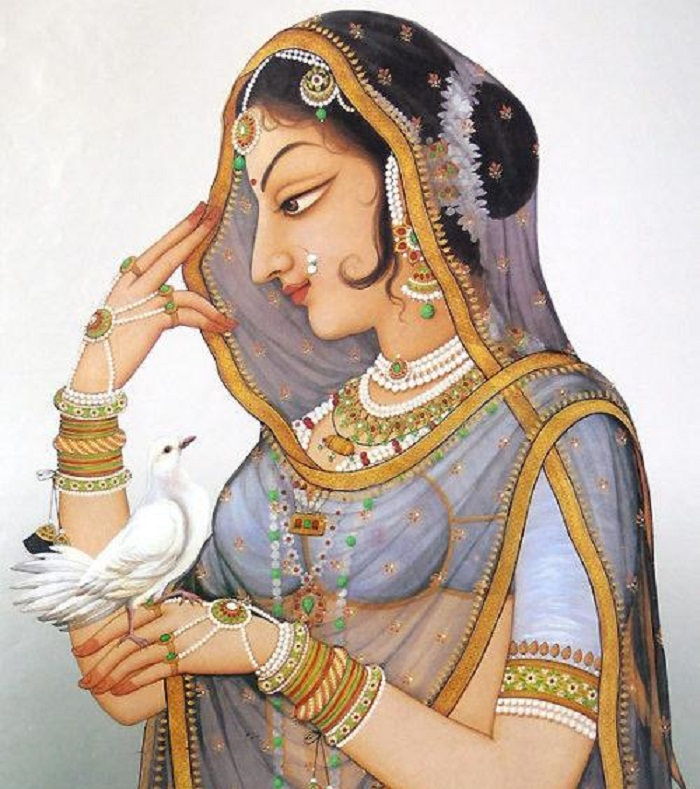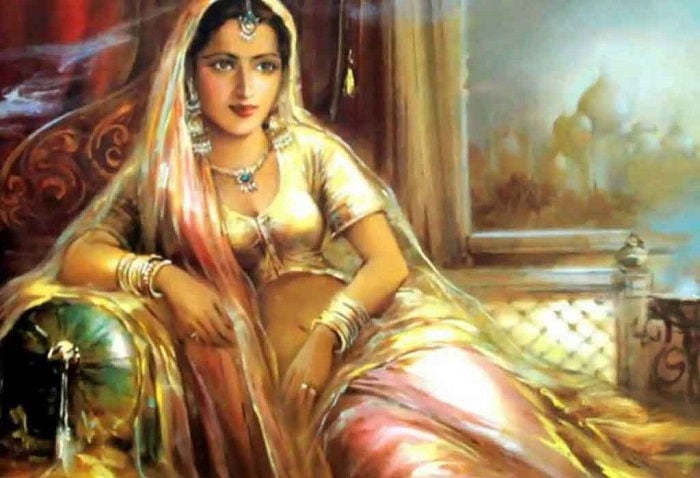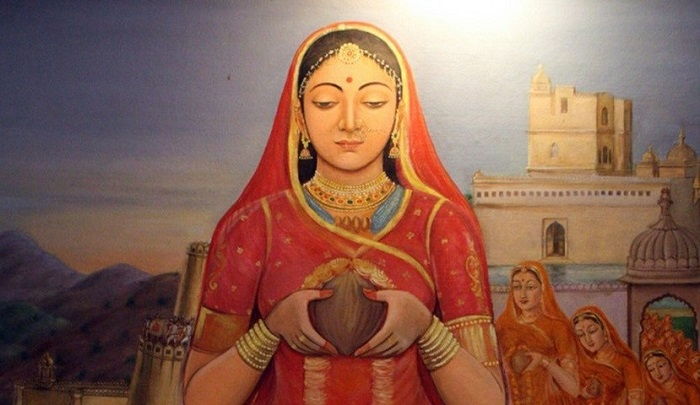Legends have it that Rani Padmini, also referred as Rani Padmavati, was an extremely beautiful 13th–14th century Indian queen. The very existence of Padmini is not manifested by any historical record and genuineness of her legends has been questioned by many modern historians. She, however, finds place in many 16th-century texts – the earliest being an epic poem ‘Padmavat’ written by Sufi poet Malik Muhammad Jayasi. According to ‘Padmavat’, Padmavati was a princess of the Singhal kingdom (presently in Sri Lanka). Learning about her beauty, Rajput ruler Ratansen (Ratan Singh) of Chittor Fort (present-day Chittorgarh in Rajasthan, India) married her following a quest. Sultan of Delhi Alauddin Khalji also drawn by her beauty invaded Chittor to acquire her. Meanwhile, Ratansen and king Devpal of Kumbhalner, who also wanted to obtain Padmavati, killed each other in a battle. Khalji attacked and captured Chittor, but to save her honour Padmavati committed Sati (widow’s self-immolation) on her husband’s pyre and other women performed Jauhar (self-immolation) to safeguard their honour. The versions in Hindu and Jain traditions differ a bit from ‘Padmavat’. She is revered as an iconic figure epitomizing both beauty and bravery.
Literary Versions of the Legend
Since the onset of 16th century variety of legends on Padmini are found on texts as well as in the regional oral lore that were retold in several languages.

Image Credit : https://www.veethi.com/india-people/rani_padmini-photos-7504-84712.htm
Padmavat
The epic poem ‘Padmavat’, one of the most famous legendary versions on Padmavati was written by Sufi poet Malik Muhammad Jayasi in 1540 CE. As per the poem, Padmavati was daughter of King Gandharvsen of Singhal kingdom. Her friendship with a talking parrot Hiraman was disapproved by her father and when he ordered to kill Hiraman, it flew away and was captured by a bird catcher and eventually ended up as a pet of Rajput ruler Ratansen of Chittor Fort. Moved by description of beautiful Padmavati from Hiraman, Ratansen crossed seven seas to reach Singhal kingdom. There he married Padmavati following a quest and then returned to Chittor with her. Ratansen banished Raghav Chetan, a Brahmin courtier for misconduct who then went to the court of Alauddin Khalji in Delhi. There the Brahmin described the unparallel beauty of Padmavati to Khalji whose desire to obtain her then led him to invade Chittor. Khalji besieged Chittor and demanded to take Padmavati which was refused by Ratansen who instead offered a tribute which was rejected by Khalji. As the siege continued Ratansen invited Khalji to his court to negotiate terms and make peace although his vassals Gora and Badal advised against it. Khalji deceitfully managed to get a glimpse of Padmavati and captured Ratansen and took him to Delhi. Padmavati requested help of Gora and Badal, who along with their followers disguised as Padmavati and her companions went inside the Delhi fortress. While the two thrived to rescue Ratansen, Gora lost his life and Badal managed to return to Chittor with the King. Hearing about Kumbhalner ruler Devpal’a marriage proposal to Padmavati in his absence, Ratansen went into a combat with the former and eventually killed each other. Following death of Ratansen, his two wives Nagmati and Padmavati embraced the funeral custom of Sati immolating themselves on his pyre. By this time Khalji’s army reached Chittor and faced with the invading army women of the fort conducted jauhar (mass self-immolation) to protect their honor while the men fought till their last breadth. Although Khalji succeeded in capturing Chittor fort he failed to obtain Padmavati.
Some of the earliest manuscripts of ‘Padmavat’ that still exist are written in different scripts including Nastaliq (Persian), Nagari and Kaithi. A Nastaliq manuscript forms the earliest extant manuscript of the poem that was copied by Muhammad Shakir in Amroha in 1675. There are other Persian manuscripts as well among which some were copied by Abdulla Ahmad Khan Muhammad of Gorakhpur in 1695 and Rahimdad Khan of Shahjahanpur in 1697. A number of additional verses are found in the Kaithi manuscripts.
Several adaptations were made from ‘Padmavat’. Among these ‘Prem Nama’ (1590) by Hansa Dakkani, a court poet of Ibrahm Shah of Bijapur Sultanate, is considered as its earliest known adaptation. Of the 12 adaptations of ‘Padmavat’ existing in Urdu and Persian language, the ‘Rat-Padam’ (1618) by Gujarat’s Mulla Abdul Shakur or Shaikh Shukrullah Bazmi and ‘Shama-wa-parwanah’ (1658) by Aqil Khan Razi, who served as governor of Delhi during Aurangzeb’s rule, are the most popular ones. The two acts opera ‘Padmâvatî’ (1923) by French composer Albert Roussel was also inspired from the poem. Screen adaptations of ‘Padmavat’ include the 1963 Tamil film ‘Chittoor Rani Padmini’, the 1964 Hindi film ‘Maharani Padmini’ and the latest 2018 Hindi film ‘Padmaavat’.

Image Credit : https://dusbus.com/kya-rani-padmini-ka-jauhar-keval-ek-kalpanik-katha-hai-ya-fir-atihasik-satya/
Rajput Versions
First Rajput adaption of the legend that was presented as a “true tale” was composed in 1589 by Hemratan titled ‘Gora Badal Padmini Chaupai’. It portrayed Padmini as sister of king of Singhal who was married to Ratan Sen (Ratan Singh). It mentions how two brave warriors Goru and Badil on Padmini’s request rescued Ratan Sen from captivity of Alauddin Khalji who desired to obtain Padmini and thus besieged Chittor. Gora died in the hands of Khalji’s army and Badil managed to bring back the king to Chittor. Gora’s wife performed sati and Gora was presented with half the throne of Lord Indra.
Several other versions of the legend came up in modern-day Rajasthan between 16th and 18th centuries that were compiled with aid of Rajput chiefs. These Rajput literary works laid more stress on honour of Rajput people in fighting against and protecting their kingdom from Alauddin Khalji.
James Tod Version
British Lieutenant-Colonel and writer James Tod included a version of the legend in his 1829 published book ‘Annals and Antiquities of Rajast’han’. He relied on both oral lore and textual versions of the legend, however it seems he gave more emphasis on bardic legends and Jain and Hindu literary works. A Jain monk named Gyanchandra is said to have helped him in researching the primary sources associated with the legend.
In his version Tod mentions Padmini as daughter of Chauhan ruler of Ceylon, Hamir Sank, who was married to Maharana Bhim Singh (alias Bhimsi), uncle and regent of Chittor’s ruler Lachhman Singh aka Lakhamsi or Lakshmanasimha. Alauddin Khalji besieged Chittor to obtain Padmini and took Bhimsi hostage. Padmini along with her uncle Gora and his nephew Badal plotted an ambush and succeeded in rescuing Bhimsi. Khalji then invaded Chittor with a huge army and when defeat seemed certain Padmini and other women conducted jauhar to kill themselves while Bhimsi and other men fought till death as Khalji captured the fort.

Image Credit : http://poshampa.org/jayasi-ki-padmavat/
Todd faced criticism for making errors in facts and dubious interpretations in his book including misrepresenting Padmini’s story where he incorrectly mentioned Lakshmanasimha (Lachhman Singh) as the ruler instead of Ratnasimha or Ratan Singh or Ratan Sen when Khalji attacked and captured Chittor.
Adaptations in Bengal
‘Padmavat’ was translated into Bengali in the 16th century. Many Bengali poems, plays and novels produced in the 19th century were also inspired from the poem. Adaptations of the James Tod version also started coming up since the 19th century. Padmini is featured as a Hindu queen in the Bengali literary pieces who conducted jauhar with other women to protect their honour from a Muslim invader. Some of the Bengali adaptations include poem ‘Padmni Upakhyan’ (1858) by Rangalal Bandyopadhyay, ‘Mewar’ (1884) by Yagneshwar Bandyopadhyay, play ‘Padmini’ (1906) by Kshirode Prasad Vidyavinode and book ‘Rajkahini’ (1909) by Abanindranath Tagore.

Image Credit : http://myvoice.opindia.com/2017/11/this-is-why-rani-padmini-chose-death/
Padmini as an Iconic & Historical Figure
The siege of Chittor by Alauddin Khalji in 1302 CE is a historical event. Its initial elucidation was found in ‘Khaza’in ul-Futuh’ by Amir Khusrau, Sufi musician, scholar and court poet of Khalji who accompanied the latter during the siege. Many other Muslim court historians wrote about this conquest sans any mention of Padmini. Nevertheless scholars like Mohammad Habib, Dasharatha Sharma, and Ashirbadi Lal Srivastava said that Padmini was veiledly referred in Khaza’in ul-Futuh by Khusrau. Padmini is also mentioned in 14th to 16th century written Jain texts like Rayan Sehra, Chitai Charitra and Nabinandan Jenudhar. Although accounts vary, Padmini has been mentioned as a historical figure in several works including that of 16th-century historians Firishta and Haji-ud-Dabir; in ‘Annals and Antiquities of Rajast’han’ by Tod; and in ‘Rajkahini’ by Abanindranath Tagore. She also finds mention in the first Prime Minister of India Jawaharlal Nehru’s book ‘The Discovery of India’ (1946).
Allegorical interpretations of the legend has also come up with Chittor symbolizing human body; Singhal the human heart; king the human spirit; the parrot as teacher; Padmini as human mind; and Khalji as worldly illusion.
Though historicity of Rani Padmini is still open to question, she embodies womanhood for Rajput Hindu women of Rajasthan who idolise her as a historical figure. She is held in high regard as a woman who typifies bravery and chose to give her life instead of surrendering herself in the hands of Muslims. Her heroic act also remained an inspiration for activists during the Indian independence movement and continues to inspire generations till present.


